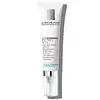What's inside
What's inside
 Key Ingredients
Key Ingredients

 Benefits
Benefits

 Concerns
Concerns

 Ingredients Side-by-side
Ingredients Side-by-side

Water
Skin ConditioningIsocetyl Stearate
EmollientGlycerin
HumectantOctyldodecanol
EmollientPropylene Glycol
HumectantPentylene Glycol
Skin ConditioningDimethicone
EmollientAcrylamide/Sodium Acryloyldimethyltaurate Copolymer
Emulsion StabilisingCetearyl Alcohol
EmollientDimethicone/Vinyl Dimethicone Crosspolymer
Skin ConditioningCaffeine
Skin ConditioningIsohexadecane
EmollientSodium Hyaluronate
HumectantSodium Hydroxide
BufferingRetinol
Skin ConditioningRetinyl Linoleate
Skin ConditioningAdenosine
Skin ConditioningAmmonium Polyacryloyldimethyl Taurate
Emulsion StabilisingCaprylyl Glycol
EmollientCitric Acid
BufferingPolysilicone-8
Polysorbate 80
EmulsifyingPhenoxyethanol
PreservativeWater, Isocetyl Stearate, Glycerin, Octyldodecanol, Propylene Glycol, Pentylene Glycol, Dimethicone, Acrylamide/Sodium Acryloyldimethyltaurate Copolymer, Cetearyl Alcohol, Dimethicone/Vinyl Dimethicone Crosspolymer, Caffeine, Isohexadecane, Sodium Hyaluronate, Sodium Hydroxide, Retinol, Retinyl Linoleate, Adenosine, Ammonium Polyacryloyldimethyl Taurate, Caprylyl Glycol, Citric Acid, Polysilicone-8, Polysorbate 80, Phenoxyethanol
Water
Skin ConditioningMethylpropanediol
SolventGlycerin
HumectantCyclopentasiloxane
EmollientButylene Glycol
HumectantHydrogenated Poly(C6-14 Olefin)
EmollientDipropylene Glycol
HumectantCaprylic/Capric Triglyceride
MaskingPanthenol
Skin ConditioningNiacinamide
SmoothingAcetyl Hexapeptide-1
Skin ConditioningPalmitoyl Tripeptide-5
Skin ConditioningAcetyl Dipeptide-1 Cetyl Ester
Skin ConditioningAcetyl Octapeptide-3
HumectantCopper Tripeptide-1
Skin ConditioningSqualane
EmollientGlyceryl Stearate
EmollientButyrospermum Parkii Butter
Skin ConditioningPolyglyceryl-3 Distearate
EmulsifyingCetearyl Olivate
C14-22 Alcohols
Emulsion StabilisingStearyl Alcohol
EmollientCetyl Alcohol
EmollientSorbitan Olivate
EmulsifyingHydrogenated Lecithin
EmulsifyingPolysorbate 60
EmulsifyingLimnanthes Alba Seed Oil
Skin ConditioningPalmitic Acid
EmollientStearic Acid
Cleansing1,2-Hexanediol
Skin ConditioningC12-20 Alkyl Glucoside
EmulsifyingAmmonium Acryloyldimethyltaurate/Vp Copolymer
Dimethiconol
EmollientEthylhexylglycerin
Skin ConditioningSodium Stearoyl Glutamate
CleansingSaccharide Hydrolysate
HumectantGlyceryl Stearate Citrate
EmollientFructooligosaccharides
HumectantAllantoin
Skin ConditioningAcrylates/C10-30 Alkyl Acrylate Crosspolymer
Emulsion StabilisingTromethamine
BufferingCaprylyl Glycol
EmollientPullulan
Dipotassium Glycyrrhizate
HumectantSaccharum Officinarum Extract
MoisturisingAdenosine
Skin ConditioningSorbitan Laurate
EmulsifyingDisodium EDTA
Sodium Hyaluronate
HumectantHydroxyethylcellulose
Emulsion StabilisingMyristyl Alcohol
EmollientMyristic Acid
CleansingHyaluronic Acid
HumectantGlucose
HumectantArachidic Acid
CleansingLauryl Alcohol
EmollientSodium Hyaluronate Crosspolymer
HumectantHydrolyzed Sodium Hyaluronate
Skin ConditioningHydrolyzed Hyaluronic Acid
HumectantCeramide NP
Skin ConditioningAtelocollagen
Skin ConditioningDesamido Collagen
Skin ConditioningOleic Acid
EmollientHydrolyzed Elastin
EmollientHydrolyzed Collagen
EmollientSoluble Collagen
HumectantSodium Acetylated Hyaluronate
HumectantHydroxypropyltrimonium Hyaluronate
Collagen
MoisturisingCollagen Amino Acids
MoisturisingProcollagen
Skin ConditioningMagnesium PCA
HumectantSerine
MaskingSucrose
HumectantGlycine
BufferingCalcium Chloride
AstringentSea Salt
AbrasiveAlanine
MaskingMagnesium Chloride
Threonine
Histidine
HumectantAspartic Acid
MaskingValine
MaskingProline
Skin ConditioningDipotassium Phosphate
BufferingLysine
Skin ConditioningLeucine
Skin ConditioningTyrosine
MaskingIsoleucine
Skin ConditioningMagnesium Citrate
Skin ConditioningGlucosamine Hcl
Phenylalanine
MaskingGlutamic Acid
HumectantArginine
Masking1-Methylhydantoin-2-Imide
Skin ConditioningAsparagine
MaskingCitrulline
Skin ConditioningMethionine
Skin ConditioningTaurine
BufferingTryptophan
MaskingFormic Acid
PreservativeGlutamine
Skin ConditioningCysteine
AntioxidantParfum
MaskingAlpha-Isomethyl Ionone
PerfumingWater, Methylpropanediol, Glycerin, Cyclopentasiloxane, Butylene Glycol, Hydrogenated Poly(C6-14 Olefin), Dipropylene Glycol, Caprylic/Capric Triglyceride, Panthenol, Niacinamide, Acetyl Hexapeptide-1, Palmitoyl Tripeptide-5, Acetyl Dipeptide-1 Cetyl Ester, Acetyl Octapeptide-3, Copper Tripeptide-1, Squalane, Glyceryl Stearate, Butyrospermum Parkii Butter, Polyglyceryl-3 Distearate, Cetearyl Olivate, C14-22 Alcohols, Stearyl Alcohol, Cetyl Alcohol, Sorbitan Olivate, Hydrogenated Lecithin, Polysorbate 60, Limnanthes Alba Seed Oil, Palmitic Acid, Stearic Acid, 1,2-Hexanediol, C12-20 Alkyl Glucoside, Ammonium Acryloyldimethyltaurate/Vp Copolymer, Dimethiconol, Ethylhexylglycerin, Sodium Stearoyl Glutamate, Saccharide Hydrolysate, Glyceryl Stearate Citrate, Fructooligosaccharides, Allantoin, Acrylates/C10-30 Alkyl Acrylate Crosspolymer, Tromethamine, Caprylyl Glycol, Pullulan, Dipotassium Glycyrrhizate, Saccharum Officinarum Extract, Adenosine, Sorbitan Laurate, Disodium EDTA, Sodium Hyaluronate, Hydroxyethylcellulose, Myristyl Alcohol, Myristic Acid, Hyaluronic Acid, Glucose, Arachidic Acid, Lauryl Alcohol, Sodium Hyaluronate Crosspolymer, Hydrolyzed Sodium Hyaluronate, Hydrolyzed Hyaluronic Acid, Ceramide NP, Atelocollagen, Desamido Collagen, Oleic Acid, Hydrolyzed Elastin, Hydrolyzed Collagen, Soluble Collagen, Sodium Acetylated Hyaluronate, Hydroxypropyltrimonium Hyaluronate, Collagen, Collagen Amino Acids, Procollagen, Magnesium PCA, Serine, Sucrose, Glycine, Calcium Chloride, Sea Salt, Alanine, Magnesium Chloride, Threonine, Histidine, Aspartic Acid, Valine, Proline, Dipotassium Phosphate, Lysine, Leucine, Tyrosine, Isoleucine, Magnesium Citrate, Glucosamine Hcl, Phenylalanine, Glutamic Acid, Arginine, 1-Methylhydantoin-2-Imide, Asparagine, Citrulline, Methionine, Taurine, Tryptophan, Formic Acid, Glutamine, Cysteine, Parfum, Alpha-Isomethyl Ionone
 Reviews
Reviews

Ingredients Explained
These ingredients are found in both products.
Ingredients higher up in an ingredient list are typically present in a larger amount.
Adenosine is in every living organism. It is one of four components in nucleic acids that helps store our DNA.
Adenosine has many benefits when used. These benefits include hydrating the skin, smoothing skin, and reducing wrinkles. Once applied, adenosine increases collagen production. It also helps with improving firmness and tissue repair.
Studies have found adenosine may also help with wound healing.
In skincare products, Adenosine is usually derived from yeast.
Learn more about AdenosineCaprylyl Glycol is a humectant and emollient, meaning it attracts and preserves moisture.
It is a common ingredient in many products, especially those designed to hydrate skin. The primary benefits are retaining moisture, skin softening, and promoting a healthy skin barrier.
Though Caprylyl Glycol is an alcohol derived from fatty acids, it is not the kind that can dry out skin.
This ingredient is also used as a preservative to extend the life of products. It has slight antimicrobial properties.
Learn more about Caprylyl GlycolGlycerin is already naturally found in your skin. It helps moisturize and protect your skin.
A study from 2016 found glycerin to be more effective as a humectant than AHAs and hyaluronic acid.
As a humectant, it helps the skin stay hydrated by pulling moisture to your skin. The low molecular weight of glycerin allows it to pull moisture into the deeper layers of your skin.
Hydrated skin improves your skin barrier; Your skin barrier helps protect against irritants and bacteria.
Glycerin has also been found to have antimicrobial and antiviral properties. Due to these properties, glycerin is often used in wound and burn treatments.
In cosmetics, glycerin is usually derived from plants such as soybean or palm. However, it can also be sourced from animals, such as tallow or animal fat.
This ingredient is organic, colorless, odorless, and non-toxic.
Glycerin is the name for this ingredient in American English. British English uses Glycerol/Glycerine.
Learn more about GlycerinSodium Hyaluronate is hyaluronic acid's salt form. It is commonly derived from the sodium salt of hyaluronic acid.
Like hyaluronic acid, it is great at holding water and acts as a humectant. This makes it a great skin hydrating ingredient.
Sodium Hyaluronate is naturally occurring in our bodies and is mostly found in eye fluid and joints.
These are some other common types of Hyaluronic Acid:
Learn more about Sodium HyaluronateWater. It's the most common cosmetic ingredient of all. You'll usually see it at the top of ingredient lists, meaning that it makes up the largest part of the product.
So why is it so popular? Water most often acts as a solvent - this means that it helps dissolve other ingredients into the formulation.
You'll also recognize water as that liquid we all need to stay alive. If you see this, drink a glass of water. Stay hydrated!
Learn more about Water